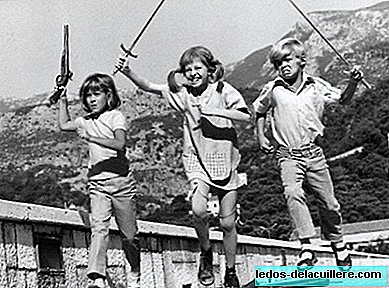
The controversy has arisen again, this time in Sweden, where a regulatory group called Reklamombudsmannen has reprimanded the toy store Top-toy (part of the group Toys R Us) for a catalog in which it showed girls playing with tea sets and boys playing with guns for considering it discriminatory and denigrating (according to the group's own words) so Top-toy After this reprimand, he shows in his catalog of Christmas 2012 both boys and girls playing with dolls, guns and kitchens claiming that the gender debate has increased greatly in Sweden in recent years and the market must adjust to social changes.
 New non-sexist Top Boy catalog
New non-sexist Top Boy catalogThe question raised by this new fact is whether advertising is to blame for this sexism or if society is to blame, that is, does advertising create that discrimination or simply recreates the existing discrimination in a particular culture and social environment?
What are sexist toys?

To contextualize, we understand by sexist toys those who reproduce and therefore perpetuate the traditional roles of men and women in society, that is, the classic stereotypes that have been related to the two sexes over the years: girls are often given domestic toys with Those who recreate the life of a housewife such as kitchens, babies, dressers and makeup games or cleaning sets while children have cars, trains or construction games. They reproduce the stereotype of patriarchal, macho society, in which the woman cleans and takes care of the babies, limiting her potential to cover other tasks while the man constructs, invents and creates alien to the household tasks. Why, however, are these toy models still stomping in our society when the role of women has evolved and changed so much?
The toys they are a double-edged sword because on the one hand are the tools that push them to experience, explore, learn, socialize or create, enhance their imagination and teach them values, through toys, children represent and imitate the roles and characters to which they have access in both family, school, street or in the media. On the other hand, toys can also enhance negative behavior models such as aggressiveness, violence, competitiveness, give little value to things for being use and throwing or the importance of physical appearance. That is why it is so important to choose a toy that does not reproduce discriminatory and archaic values.
Now the toy choice It does not depend so many times on the parents as on the children and on the influence they receive that, often, as I have commented, it is given by the school, the street, other children, other parents and the media. Is it possible to change toys when society still reproduces discriminatory models? How can you make sure that, even if you promote equal education, your child is not contaminated with external factors?
The case of Egalia: the school without sex
 Egalia School
Egalia SchoolA curious case, also in Sweden, is that of the preschool Egalia which is based on equality and gender distinction. Students are not "boys" and "girls", they are simply "colleagues" or "friends" (buddies Y friends, in English), for them everything is neutral, they use the Finnish pronoun “hen“Which serves to refer to both a man and a woman. At school they take great care of the absence of sexual references and stereotypes: they create their own stories so as not to influence children with stories like Cinderella or Snow White and they even take care of the placement of the toys (the Lego are next to the kitchens) so as not to make the classic distinction between “boy or girl” toys. According Lotta Rajalin, director of the center, the goal of the school is “make children have a broad perspective of life and not be left with only one half. We do not want them to grow as if they were inside closed boxes, according to a mentality that expects them to be in a certain way, male or female. We want them to be just as they want to be, to become free human beings“.
Egalia She wants to get away from these stereotypes to the fullest, giving her students freedom, so they won't feel self-conscious if they are boys and decide to play with a doll or if they are girls and they are attracted to cars. Free children from sexual complexes and get them to apply what they learned in their homes.

If a child is attracted to a cooking game there is nothing wrong or weird about it. It is possible that this child sees in his house the collaboration between his parents when assigning household chores and therefore, does not find it strange or abnormal to opt for that type of game, even playing with dolls that are traditionally assigned to girls It can teach you such important concepts as the responsibility or care of others. The important thing when buying a toy is to look for the educational component of the toy, that is, what will you learn or will bring that toy in addition to the fun, as long as you receive the values you want to convey to your child, What does it matter if that toy is traditionally "girls'" or "boys" ?.
Page to page discrimination
 The children of Imaginarium distribute the housework.
The children of Imaginarium distribute the housework.I have right in front of a series of Christmas toy catalogs from various stores such as To field, Leclerc, Carrefour, Imaginarium, Toys R Us Y Dideco. The only two non-sexist catalogs are those of Imaginarium Y Dideco, the rest are a representation of all the gender stereotypes that may come to our minds: dolls, babies and kitchens are presented on a pink background, in the images, girls are the ones that appear cooking except once.
 Catalog for girls.
Catalog for girls.In the case of children's toys the background is blue or green and in the case of "neutral" or unisex toys, they opt for a yellow or white background. Inside the toys for girls we find dolls (both babies and the classic Barbie or similar), kitchens and cleaning games (washing machine, iron and board), baby carriages and cribs and little houses while in children we see cars, trucks, helicopters airplanes and motor in general, guns, board games, dolls of Superheroes, robots, ships and castles. That is, while a boy can live many adventures, a girl can only play cooking, ironing and caring for babies. Girls' fun is therefore limited to home and housework according to these catalogs, which is just as negative for girls as for boys, who are always required to be strong, hard and manly, in short, five-headed machets years.
 Catalog for children.
Catalog for children.On the contrary, in Imaginarium We did not find this differentiation: they forget to use the topics of pink and blue and show children of both sexes playing kitchens, dolls, there are costumes and accessories for many trades. Dideco It has educational toys and there is no distinction, except for the old one, in its catalog.
Gender roles are a social construction and therefore, your child can choose to play with whatever he wants, after all the most important thing is that he has fun and learn playing and that these toys convey good values and behaviors. Catalogs often achieve with this sexist division that children reduce the choice of their toys to the pink background or the blue background, when in fact it has a wide range of possibilities with which to entertain and play. The most important thing is not to force children to choose a certain toy simply because it is what they are expected to play with and give them that freedom of choice and decision about what they want and what they want to play with.
What do you think about it? Do you consider these sexist and discriminatory catalogs? Do you think that toy catalogs influence your children's decision making?












